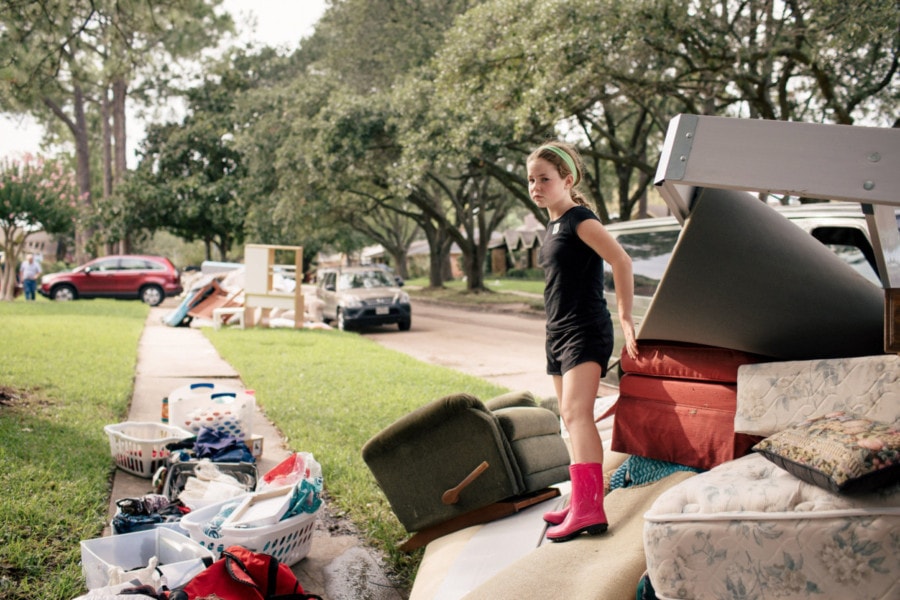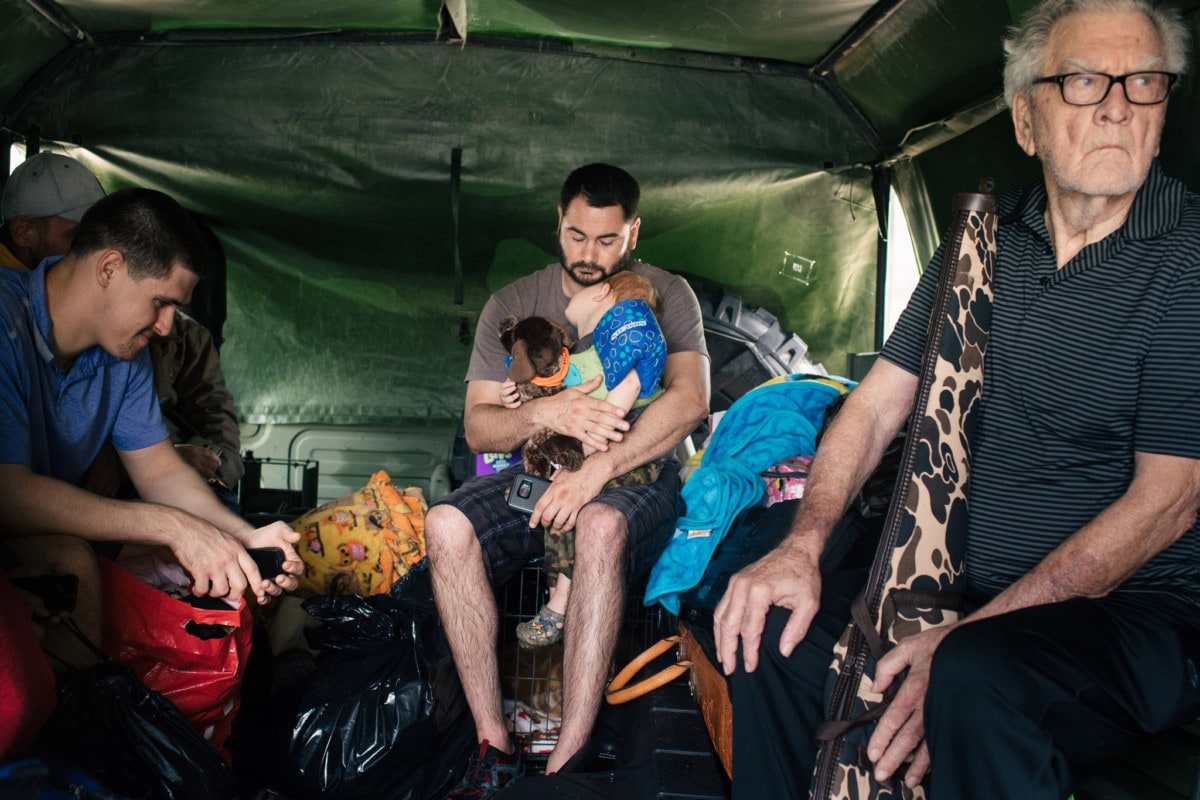Share
How One Photojournalist Covered Hurricane Harvey: Alyssa Schukar in Houston
Chicago-based freelance photojournalist, Alyssa Schukar (@alyssaschukar), has been covering Hurricane Harvey and its aftermath for the New York Tim...

Chicago-based freelance photojournalist, Alyssa Schukar (@alyssaschukar), has been covering Hurricane Harvey and its aftermath for the New York Times. We spoke to her via phone to get some insight into covering a tragedy with so many logistical challenges.

Alyssa Schukar for The New York Times
You knew Harvey was going to be a huge storm with significant flooding after the fact. How do you prepare for this environment?
I did not have a great deal of time to prepare. I woke up on Friday morning with a note from an editor I work with a lot from the New York Times asking if I could go down to Houston. I live in Chicago. She was trying to me on a 12:30pm flight, but I ended up pushing it until 3:30pm, and by 5:30pm I was in Houston.
It’s definitely a logistical struggle here, especially when the water was still high. I think it’s become a lot easier though. As I was trying to get to a New York Times colleague’s house to do laundry, I got re-routed a number of times because flooding is still happening. There are still large swaths of Houston that are covered in water.
This reminds me in a lot of ways of experiences I’ve had before [Schukar has worked in Afghanistan]. I’ve ended up spending a lot of time with the National Guard here in Houston. They’ve been doing rescue work and recovery work, and that’s been really nice because that’s meant that I’ve had good access to what’s happening. And I’ve also been able to travel with them which means that I haven’t had to worry about flooding out my car.
The reporter that I’ve been working with, Alan Blinder, we lost a car on Sunday coming into the city when we were basically trying to drive through a flooded overpass. It’s definitely not something you can prepare yourself for, but you go in with as much gear as you can and as much previous experience as you can, and you sort of work off of it from there.

Alyssa Schukar for The New York Times
Once you were on the ground, what surprised you?
Sunday was pretty wild. I ended up hopping on a fishing with two guys who were going out to the Meyerland neighborhood to save people. As we were going around, we were very cautious because there were cars floating just under the surface. So if the boat ran into the car, it would potentially capsize or ruin the engine. That was certainly not something I was expecting.
As the day went on, more boats were out there, so it felt a little bit more like people were going to be saved. But there were definitely moments where I saw desperate looks on people’s faces, and I felt powerless. I couldn’t do much of anything for them.
You can’t really prepare yourself for that. But there were a lot of people that we came back for later on the fishing boat who had already been rescued, so that was very encouraging.
You’re one of many photographers covering the disaster for the NY Times. How is the storytelling coverage divvied up?
A lot of us have been paired with writers. It depends on what your schedule is like and where you’re located. A lot of this has been enterprise work – going out there and finding something that will make for a good story, but also having an idea on what the writers are working on, and trying to illustrate that as best we can.
I’ve been working a lot with Alan Blinder, and there have been a couple other photographer/writer teams, especially at the beginning of the storm. And now I think [the story is] moving onto larger picture pieces. We’re continuing to do the stories and photos of rescue work, but it’s now moving to “Where does Houston, where does Texas move on from here?”
What sort of feedback are you getting from the newsroom?
Crista Chapman has been running this from New York along with Morrigan McCarthy, and they have both been wonderful. Poor Crista has been maybe getting 4 hours of sleep but she’s been an absolute champ – both championing our work in the newsroom and creating spaces for that work, as well as giving us time to recover to take care of ourselves, and do the work that we want to do.
We’re definitely given a fair amount of freedom. We just gotta hit those deadlines!
Do you think the media is doing a good job covering the disaster?
I’m gonna be honest with you. I have not had the time to look at what has been in the media. Saturday through Wednesday, it’s been these crazy long marathons. Going around with the National Guard has meant long hauls because once you go out with the soldiers, you’re stuck with them.
I haven’t been paying much attention. I’ve seen what the New York Times has been doing, but beyond that I can’t answer that question. I do think the New York Times has been doing an exemplary job.
You’re a freelancer. Do you have any concerns about going into an adverse environment, or do you feel like the organizations that are hiring you have your back if things go south?
I do think the Times has my back and that’s certainly an advantage of a large publication. But I’m still trying to take as much precaution as I can. Of course, you can’t stop everything. I’ve definitely touched contaminated water. I’m trying to minimize risk as much as possible, but the reality is that it’s an unsafe situation, and the water is getting worse here. And that’s going to be one of the big issues going forward from this first week – people being exposed to toxins in the air and the water.
This interview has been lightly edited for clarity.
Many photojournalists have been covering the hurricane and its devastating aftermath. Here are a few more doing stellar work: Ashley Landis (@ashphotog), Luke Sharrett (@howdyluke), Jabin Botsford (@jabinbotsford), Andrew Burton (@andrewburton11), Tamir Kalifa (@tamirhasacellphone), Erin Trieb (@erintrieb), John Taggart (@jtaggphoto), Adrees Latif (@adreeslatif), Brendan Smialowski (@bsmialowski), Michael Ciaglo (@michaelciaglo), Steve Gonzalez (@gonzophotoman), Elizabeth Conley (@egconley), Mark Mulligan (@mrkmully), Melissa Phillip (@melissaphillip713), Karen Warren (@karen_warren_801), Yi-chin Lee (@yichin.lee), Brett Coomer (@bcoomer713), Jon Shapley (@jonjshapley), Godofredo Vasquez (@godovasquez), Marie D. De Jesús (@mariedennise)
This post has been updated to include the staff of the Houston Chronicle


